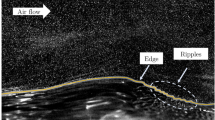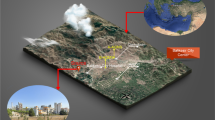Abstract
The role of modelling the atmospheric dispersion of pollutants at microscale, the scale that allows to resolve explicitly the presence of obstacles, is becoming increasingly important for performing air quality assessments in cities, as well as for regulatory purposes and for the design of pollution control strategies. However, the use of microscale models can be computationally demanding, both in terms of time and CPUs required, especially if the computational domain considers wide spatial extension and the simulation considers long time periods. This article proposes the application of a kernel method as the concentration calculation methodology inside microscale Lagrangian particle dispersion models (LPDMs) in order to reduce the required computational time. In these models, the concentration is normally estimated with the box-counting method, while the use of this alternative method, based on the use of the statistical technique of kernel density estimation, allows for a reduction of numerical particles emitted during the simulation, while guaranteeing a similar accuracy to that of the box-counting method. It therefore enables an optimization of computational efficiency. In an earlier manuscript, the kernel method was applied inside the LPDM of the PMSS (Parallel-Micro-SWIFT-SPRAY) system to perform high-resolution simulations of line sources, enabling an 80% simulation time reduction. In this article, additional features of this method are developed within the Micro-SPRAY model and tested through two test cases. The kernel method has been applied to estimate the pollutant concentrations of point sources as well as to compute the corresponding deposition at building-resolving scale. The results with tiled and nested configurations of domains are also verified.





Similar content being viewed by others
Data availability
The datasets generated during the current study are available from the corresponding author on request.
References
Badach J, Wojnowski W, Gębicki J (2023) Spatial aspects of urban air quality management: estimating the impact of micro-scale urban form on pollution dispersion. Comput Environ Urban Syst 99. https://doi.org/10.1016/j.compenvurbsys.2022.101890
Barbero D, Tinarelli G, Silibello C, Nanni A, Gariazzo C, Stafoggia M, Viegi G (2021) A microscale hybrid modelling system to assess the air quality over a large portion of a large European city. Atmos Environ 264:118656. https://doi.org/10.1016/j.atmosenv.2021.118656
Barbero D (2019) Sviluppo e applicazione del metodo kernel in modelli lagrangiani a particelle a scala locale e a microscala. Master’s Degree Thesis, Politecnico di Milano. http://hdl.handle.net/10589/146531
Boughton BA, Delaurentis JM, Dunn WE (1987) A stochastic model of particle dispersion in the atmosphere. Bound-Layer Meteorol 40:147–163. https://doi.org/10.1007/BF00140073
Chang JC, Hanna SR (2004) Air quality model performance evaluation. Meteorol Atmos Phys 87:167–196. https://doi.org/10.1007/s00703-003-0070-7
COST ES1006 (2015a) Evaluation, improvement and guidance for the use of local-scale emergency prediction and response tools for airborne hazards in build environments. Model Evaluation Case Studies, COST Action ES1006 Tech. Rep. COST Action ES1006. https://doi.org/10.1007/978-94-017-9891-4_13
COST ES1006, (2015b) Evaluation, improvement and guidance for the use of local-scale emergency prediction and response tools for airborne hazards in build environments. Best Practice Guidelines, COST Action ES1006 Tech. Rep. COST Action ES1006. https://doi.org/10.1007/978-94-017-9891-4_13
COST ES1006 (2015c) Evaluation, improvement and guidance for the use of local-scale emergency prediction and response tools for airborne hazards in build environments. Model evaluation protocol, COST Action ES1006 Tech. Rep. COST Action ES1006. https://doi.org/10.1007/978-94-017-9891-4_13
Crawford A (2020) The use of Gaussian mixture models with atmospheric Lagrangian particle dispersion models for density estimation and feature identification. Atmosphere 11:1369. https://doi.org/10.3390/atmos11121369
de Haan P (1999) On the use of density kernels for concentration estimations within particle and puff dispersion model. Atmos Environ 33:2007–2021. https://doi.org/10.1016/S1352-2310(98)00424-5
Fenlason J, Stallman R (1997) The GNU profiler. Free Software Foundation, Inc. https://ftp.gnu.org/old-gnu/Manuals/gprof-2.9.1/html_mono/gprof.html
Hanna SR, Briggs GA, Hosker RP (1982) Handbook on atmospheric diffusion. DOE/TIC-11223. Department of Energy, p 102. https://doi.org/10.2172/5591108
Lorimer GS (1986) The kernel method for air quality modelling – mathematical foundation. Atmos Environ 20:1447–1452. https://doi.org/10.1016/0004-6981(86)90016-8
Monforti F, Vitali L, Pagnini G, Lorenzini R, Delle Monache L, Zanini G (2006) Testing kernel density reconstruction for Lagrangian photochemical modelling. Atmos Environ 40(40):7770–7785. https://doi.org/10.1016/j.atmosenv.2006.07.046
Oldrini O, Armand P, Duchenne C, Olry C, Moussafir J, Tinarelli G (2017) Description and preliminary validation of the PMSS fast response parallel atmospheric flow and dispersion solver in complex built-up areas. Environ Fluid Mech 17:997–1014. https://doi.org/10.1007/s10652-017-9532-1
Oldrini O, Olry C, Moussafir J, Armand P, Duchenne C (2011) Development of PMSS, the parallel version of Micro–SWIFT–SPRAY. Paper presented at the 14th international conference on harmonisation within atmospheric dispersion modelling for regulatory purposes, Kos, Greece, 2011. https://www.harmo.org/Conferences/Proceedings/_Kos/publishedSections/H14-176.pdf
Thomson D (1987) Criteria for the selection of stochastic models of particle trajectories in turbulent flows. J Fluid Mech 180:529–556. https://doi.org/10.1017/S0022112087001940
Tinarelli G, Brusasca G, Oldrini O, Anfossi D, Castelli ST, Moussafir J (2007) Micro-Swift-Spray (MSS): a new modelling system for the simulation of dispersion at microscale. General description and validation. In: Borrego C, Norman AL (eds) Air Pollution Modeling and Its Application. Springer, Boston, MA. https://doi.org/10.1007/978-0-387-68854-1_49
Tinarelli G, Mortarini L, Trini Castelli S, Carlino G, Moussafir J, Olry C, Armand P, Anfossi D (2012) Review and validation of Micro-Spray, a Lagrangian particle model of turbulent dispersion. In: Lin J, Brunner D, Gerbig C, Stohl A, Luhar A, Webley P (eds) Lagrangian Modeling of the Atmosphere, vol 200. Geophysical Monograph, American Geophysical Union, Washington DC, pp 311–327. https://doi.org/10.1029/2012GM001242
Uliasz M (1994) Lagrangian particle dispersion modeling in mesoscale applications. Computational Mechanics Publications, Environmental Modelling II’, pp 71–102
Willmott CJ (1981) On the validation of models. Phys Geogr 2(184):194. https://doi.org/10.1080/02723646.1981.10642213
Zhang K, Chen G, Wang X, Liu S, Mak CM, Fan Y, Hang J (2019) Numerical evaluations of urban design technique to reduce vehicular personal intake fraction in deep street canyons. Sci Total Environ 653:968–994. https://doi.org/10.1016/j.scitotenv.2018.10.333
Author information
Authors and Affiliations
Contributions
Conceptualization: D.B., G.T. Methodology: D.B., G.T., B.R. Writing-original draft preparation: D.B. Writing-review and editing: D.B., B.R. Supervision: G.T., M.N.
Corresponding author
Ethics declarations
Ethics approval and consent to participate
Not applicable.
Consent for publication
Not applicable.
Competing interests
The authors declare no competing interests.
Additional information
Publisher's Note
Springer Nature remains neutral with regard to jurisdictional claims in published maps and institutional affiliations.
Rights and permissions
Springer Nature or its licensor (e.g. a society or other partner) holds exclusive rights to this article under a publishing agreement with the author(s) or other rightsholder(s); author self-archiving of the accepted manuscript version of this article is solely governed by the terms of such publishing agreement and applicable law.
About this article
Cite this article
Barbero, D., Ribstein, B., Nibart, M. et al. Reduction of simulation times by application of a kernel method in a high-resolution Lagrangian particle dispersion model. Air Qual Atmos Health (2023). https://doi.org/10.1007/s11869-023-01472-4
Received:
Accepted:
Published:
DOI: https://doi.org/10.1007/s11869-023-01472-4




